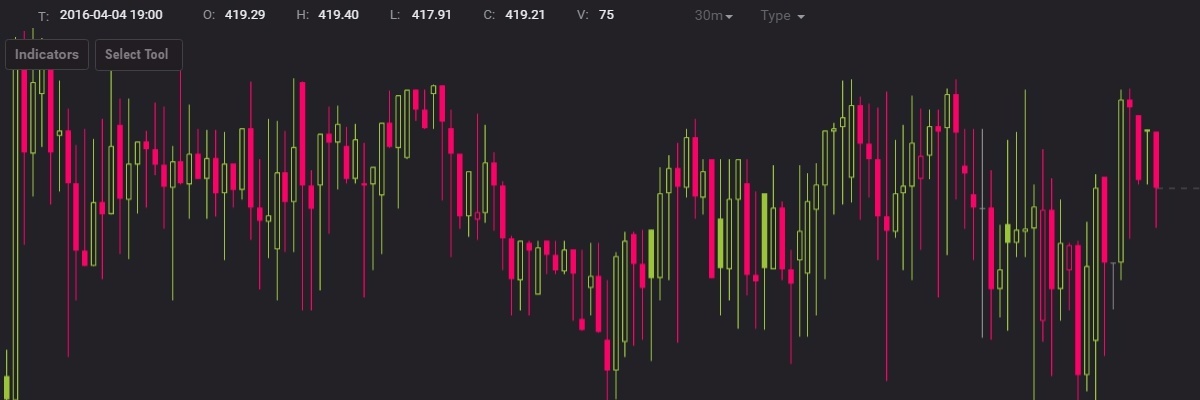Cryptocurrency market - trading marketplace, where traders exchange one cryptocurrency on another or fiat money.
"Bull" (buyer) - bidder who buys a financial instrument with hope of growing its value in order to make money.
"The Bear" (dealer) - bidders who actively sell the currency, makes a fall of its value.
Hamster - a player on the market, who hasnt't got any experience and does not know or understand the patterns of market.
Whale - the trader with experience.
Spread - the difference between the best selling price (Ask) and buying price (Bid) for currency proposed at the moment on the market.
Ask - the price at which a seller is willing to sell the currency.
Bid - the price at which a buyer is willing to buy the currency.
Candlesticks - a graph that reflects the price movement over a specific time period, and allows you to find the necessary information on market sentiment.
The body of the candle - the widest part of the candle, which shows the price range between the opening and closing prices over a certain period of time.
Bear candle - means depreciation of rate (price level of the opening above the closing level). It has a white or green color.
Bull candle - means appreciation of rate (price level of the opening below the closing level). It has black or red color.
Candles shadow - fine lines, which depart from the candles and indicate the presence of recorded minimums and maximums.
The long upper candles shadow - means the domination of the bulls (buyers), which raised the price to the maximum.
The long lower candles shadow - means the domination of the bears (sellers), which lowered the price to a minimum.
Spinner - candles that have approximately the same length shade, means uncertainty in the market at this time.
Bubble - a situation in which there is a high demand for foreign currency (items). As the result, the price for it increases greatly, causing a further increase in demand for the currency.
Short position - a situation, where the broker borrows trader money in debt. Opening a short position, a trader expects to earn in the market fall.
Long position - a situation in which a trader buys a currency at a low price, waiting for the course rising and then sell the currency more expensive to obtain their profits.
The level of resistance - is a chart point or range that caps an increase in the level of a stock or index over a period of time.
The level of support- is the price level which, historically, a stock has had difficulty falling below.
Closing position: closing of a long position is the sale of assets, closing of a short position - the purchase of an asset.
Pump - planned "lifting" of the course, caused by big players.
Dump - planned "collapse" of the course, caused by big players.
Market order - an order, which is used in case of an urgent opening or closing a position at the market; means a willingness to buy or sell currency at the current market price.
Pending order - the type of order, which parameters sets in advance; opens in case of market prices specified by the trader.
Passive order - an order to buy/sell a specified amount of currency at a specified price or better, rather than the current market rate.
Limit buy order - an order to buy currency at a specified price or lower. It is used by the trader, if he expects a price drop to a certain level, after which the price will start to rise again.
Limit sell order - an order for sale at a specified price or higher. It is used by the trader, if he expects to increase prices to a certain level, after which the price will begin to fall again.
Order book - a list of all the market limit orders.
Price Loss - the last price at which the transaction was made on the market.
Stop-loss buy - an order to buy at a specified price or higher. It is used by the trader, if he expects to increase prices to a certain level, after which the price continues to rise.
Stop-loss sell - an order for sale at a specified price or lower. It is used by the trader, if it expects price drop to a certain level, after which the price continues to go down.
Open - the quotation at the time of opening of tenders, which forms the daily trend.
Close - the quotation at the close of trading, which displays the price of the last transaction on the market.
Timeframe - the time interval, which is used for the market groups in the construction of bars or candles (M - minute, of H - hour, D - Day, the W - a week, the MN - month, the Y - year).
Schedule of trading volume - represents the total cryptocurrency, which was bought / sold for a certain time period.
Fiat money - money, which value is set by the government (euro, dollar, ruble, hryvna, etc.)
Trend - a general direction of price movement. If each maximum of trend is above the previous - the trend is up. If each minimum of trend is below the previous - the trend is downward.
Draining - the situation when the market rate falls by 10-12% because of the actions of sellers (bears).
The wall - a large order buy or sell, which creates an obstacle movement rate up or down.
Mowing - the situation on the market, especially when experienced traders provoke the growth rate or a fall, to earn through "hamster".
Volatility - sharp jumps in prices.
